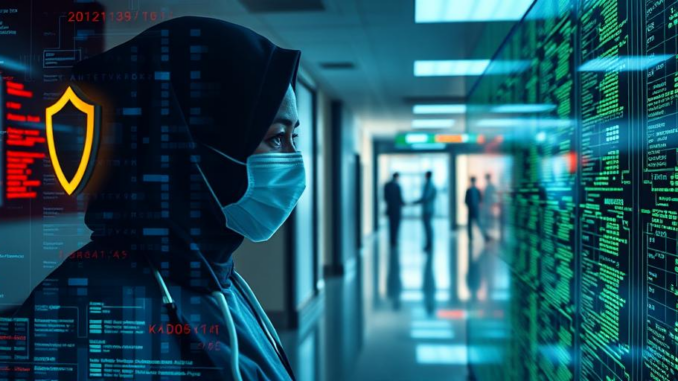
Summary
This article provides a guide for hospitals to enhance their data security. It emphasizes the importance of system monitoring apps, outlines key features to look for, and suggests integration with broader security measures. By following these steps, hospitals can strengthen their defenses and protect sensitive patient data.
Safeguard patient information with TrueNASs self-healing data technology.
** Main Story**
Protecting patient data, it’s more than just ticking boxes for legal compliance, you know? It’s really the bedrock of trust between patients and their healthcare providers, and it allows for quality care. And in this digital age, hospitals are in the firing line, facing a growing number of cyber threats. That’s why having rock-solid data security measures is absolutely essential. So let’s dive into how you can boost your hospital’s defenses, especially by focusing on how important system monitoring apps are.
Why System Monitoring is a Must-Have
Think of system monitoring apps as the ever-watchful eyes and ears of your hospital’s entire network. I mean, they give you real-time insights into what’s happening across all your devices and systems. Essentially, they’re like those security guards you see, constantly on patrol but in the digital world.
They’re fantastic for detecting suspicious activity. Identifying any potential weaknesses, and making sure you’re following all those strict healthcare rules and regulations, like HIPAA. Because they help you spot potential problems early, you can take action before anything spirals into a major crisis. System monitoring apps become your first line of defense. They’re your early warning system, helping you patch up vulnerabilities and keep damage to a minimum. It’s a proactive approach, rather than just reacting after something bad has already happened.
Choosing the Right App: What to Look For
Now, picking the right system monitoring app, it’s not a one-size-fits-all thing. You’ve got to really think about what your hospital specifically needs. Here’s what I’d be keeping an eye out for:
- Real-time Monitoring and Alerting: The app needs to be constantly watching, like 24/7 vigilant. If anything looks fishy, you need to know about it ASAP. That way, you can jump on it and deal with any threats quickly. It is vital.
- Comprehensive Device Coverage: It can’t just cover some devices, it needs to see everything! Servers, workstations, medical equipment, even those IoT devices that are increasingly common in hospitals. Total visibility is key.
- Anomaly Detection: This is where it gets clever. The app should be able to spot when something isn’t quite right, when activity deviates from the norm. Even if it’s a sophisticated attack that’s designed to slip under the radar, this feature can help you catch it.
- Integration Capabilities: The app shouldn’t exist in its own little bubble. It needs to play nicely with your other security systems, like firewalls and intrusion detection systems. A seamless integration makes threat response much smoother.
- Compliance Reporting: Let’s face it, compliance is a headache. The app should make it easier by providing detailed reports that show you’re meeting all the necessary healthcare regulations.
The Bigger Picture: Security Beyond Monitoring
A system monitoring app is a vital tool, but it’s just one piece of the puzzle. It needs to be part of a broader security strategy. Think of it like this, you’ve got your monitoring app as your alarm system, but you still need to ensure your doors and windows are locked. Here are some other things you should be thinking about:
- Access Control: You really need to control who can access what data. Only give people access to what they need for their jobs, and nothing more. Role-based access control is your friend here.
- Data Encryption: Encrypt everything. Patient data should be encrypted when it’s being sent and when it’s just sitting on your servers. That way, even if someone does manage to get access, they won’t be able to read it.
- Regular Security Assessments: Don’t just set it and forget it. Regularly check your security measures to see if there are any holes. Penetration testing can be really helpful here.
- Staff Training: Your employees are often the weakest link. Make sure they know about cybersecurity best practices, especially how to spot phishing attacks. You’d be surprised how many breaches start with someone clicking on a dodgy link.
Don’t Stand Still: Continuous Improvement
The cybersecurity landscape is always changing, new threats popping up all the time. It’s like trying to hit a moving target. That’s why you have to constantly evaluate and improve your hospital’s security.
For example, I remember one time when my previous company, their security system had a blind spot regarding some new form of ransomware. But by the time we’d got the update and fixed it, the damage was already done! Review how well your system monitoring app and other security measures are working, and don’t be afraid to make changes to keep ahead of the curve.
Basically, by taking these steps and integrating system monitoring apps, you’re seriously boosting your hospital’s ability to keep sensitive data safe, keep your patients’ trust, and deliver the best possible care. It’s not just about avoiding fines or bad press; it’s about doing what’s right for your patients, right? It is also worth noting that the information security field is a constant journey of improvement and evaluation.


HIPAA compliance: more fun than a root canal, right? Seriously, though, beyond ticking boxes, how are hospitals using system monitoring data to proactively *improve* patient care, not just protect data? Are we seeing AI analyze this data to predict and prevent medical errors, too?
That’s a great point! I’m seeing some forward-thinking hospitals explore AI-driven analysis of monitoring data to predict equipment failures *before* they impact patient care. It’s still early stages, but the potential for proactive intervention is definitely there and a game changer for care quality!
Editor: MedTechNews.Uk
Thank you to our Sponsor Esdebe